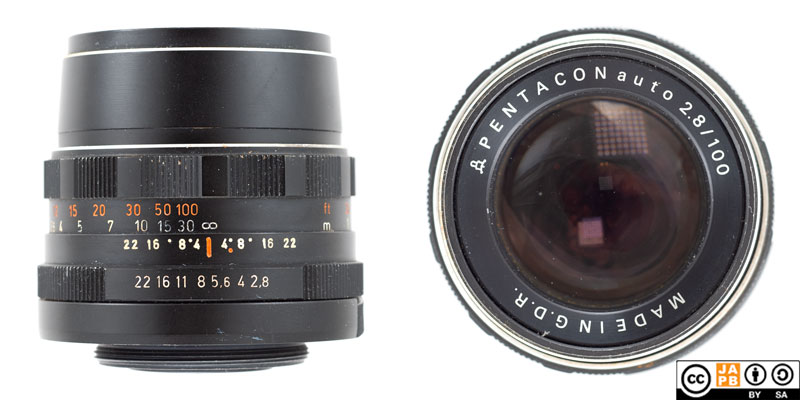Pekka Buttler, 07/2025
This lens has also been on a JAPB walk-around. If you’re interested in imagery and impressions, please refer to that walk-around.

Specifications
The table below summarizes the lens’ key specifications (measurements based on pictured sample):
| Brand: | Pentacon | Lens name | auto 2.8/100 |
| Focal length(s) 1 | 100 mm | Angle-of-view 2 | 24 ° |
| Maximum Aperture | f/2.8 | In Production | 1970–1975 |
| Lens mount (this lens) | M42 | Other lens mounts | Exakta (RTL variant) |
| Length 3 | 57,7 mm | Diameter 4 | 63,4 mm |
| Filter ring diameter | 49 mm | Weight | 282 grams |
| Lens element count | 5 | Lens group count | 4 |
| Aperture blades (S/R/C) 5 | 6 S | Focus throw | 330 ° |
| Minimum focusing distance (measured) | 105 cms | Maximum magnification (measured) | 1:8,4 |
| Has manual aperture ring | YES | Has Manual focus ring | YES |
| Aperture mechanism type | Automatic | Aperture click stops 6 | 2.8•4•5.6•8•11•16•22 |
Further notes:
• This lens is optically the same lens as the Meyer-Optik Görlitz Orestor 100/2.8.
• The MOG Orestor 100/2.8 was introduced in the late 1960s and after the state-directed merger of Meyer-Optik Görlitz into VEB Pentacon, the lens continued to be sold as the Pentacon 100/2.8
• There were four version of the Pentacon 100 mm f/2.8. See more under ‘versions‘
Versions
The preceding MOG Orestor 100/2.8 was introduced in two versions: a preset aperture (with click stops) version (M42 or Exakta), and a version with automatic aperture, with stop-down button. This automatic aperture variant could be either of the M42 auto (m42 with stop-down pin) and M42 electric (three electric contacts for communicating aperture setting and stop-down pin).
After Pentacon took over the MOG lens catalogue the M42 versions remained in the lineup, but the preset Exakta was discontinued. Instead, the Pentacon 100/2.8 exists with a mount designed to be used with the Exakta RTL 1000.
In short: the following (mechanically distinct) versions exist (which have identical optics):
• Pentacon 100/2.8 M42 automatic
• Pentacon 100/2.8 M42 electric
• Pentacon 100/2.8 Exakta RTL 1000
Finally, there might be some samples of a Pentacon 100/2.8 M42 Preset (these would have been remaining stocks of Orestor 100/2.8 preset parts being sold off in the midst of the rebadging).
There are at least two cosmetic variants of the Pentacon 100/2.8:
• One version with broad zebra stripes on the aperture ring and with the background for aperture values in silver (but otherwise black)
• One all-black version (pictured sample)
History of Pentacon
Pentacon – more precisely VEB Pentacon – was an East German state-owned camera and optics combinate that was very influential (also outside the East Bloc) from its inception until the demise of the East German people’s republic.
But Pentacon was not born out of thin air. Therefore any real appreciation of Pentacon – either as a camera maker or as an optics manufacturer – has to start with a back story. Read more in the JAPB company profile on Pentacon …
Adapting
n.B! The following applies this lens in either Exakta or M42 mount.
This lens cannot be used natively on any current SLR or dSLRs. To use it in its native environment, you will need an Exakta or M42-mount film body. Luckily there are a lot of those (especially in M42 mount) available.
Thanks to being a fully manual lens (manual aperture, manual focus), the lens can be adapted to all mirrorless cameras using a suitable adapter. Moreover, both Exakta and M42 lenses are so uncomplicated that a simple ‘dumb adapter’ will do the job perfectly. Moreover, due to the popularity of both mounts, special adapters (helicoid adapters, tilt/shift adapters) are readily available. Alternatively, one can choose to daisy-chain adapters (e.g. M42->Canon EF; Canon EF –> mirrorless) which also opens up a wide range of speed boosters .
Using m42 and Exakta lenses on dSLRs can also be an easy option, depending on which dSLR.
• Canon EF has the shortest flange focal distance among full-frame dSLR’s and Canon’s wide range of dSLRs are able to mount both M42 and Exakta lenses perfectly using a simple adapter ring.
• Minolta / Sony A dSLRs are likewise able to mount M42 lenses using a simple adapter ring, but for Exakta lenses, the difference in flange focal distances is not enough to enable reaching infinity focus without an adapter that uses corrective optics.
• Pentax K dSLRs are likewise able to use M42 lenses using a simple adapter ring, but for Exakta lenses an adapter that uses corrective optics would be needed to allow infinity focus.
• Nikon F dSLRs have a long flange focal distance, meaning that mounting either M42 or Exakta lenses needs an adapter that uses corrective optics to allow anything close to infinity focus.
Footnotes
- Focal length is (unless stated otherwise) given in absolute terms, and not in Full-frame equivalent. For an understanding of whether the lens is wide/tele, see ‘Angle-of-view’. ↩︎
- Picture angle is given in degrees (based on manufacturers’ specs) and concerns the diagonal picture angle. Rule of thumb:
> 90 ° ==> Ultra-wide-angle
70–90 ° ==> Wide-angle
50–70 ° ==> Moderate wide-angle
40–50 ° ==> ‘Standard’ or ‘normal’ lens
20–40 ° ==> Short tele lens
10-20 ° ==> Tele lens
5-10 ° ==> Long tele lens
< 5 ° ==> Ultra-tele lens ↩︎ - Length is given from the mount flange to the front of lens at infinity. ↩︎
- Diameter excludes protrusions such as rabbit ears or stop-down levers. ↩︎
- S=straight; R=rounded; C=(almost)circular at all apertures. ↩︎
- Numbers equal aperture values on aperture ring; • intermediate click; – no intermediate click. ↩︎